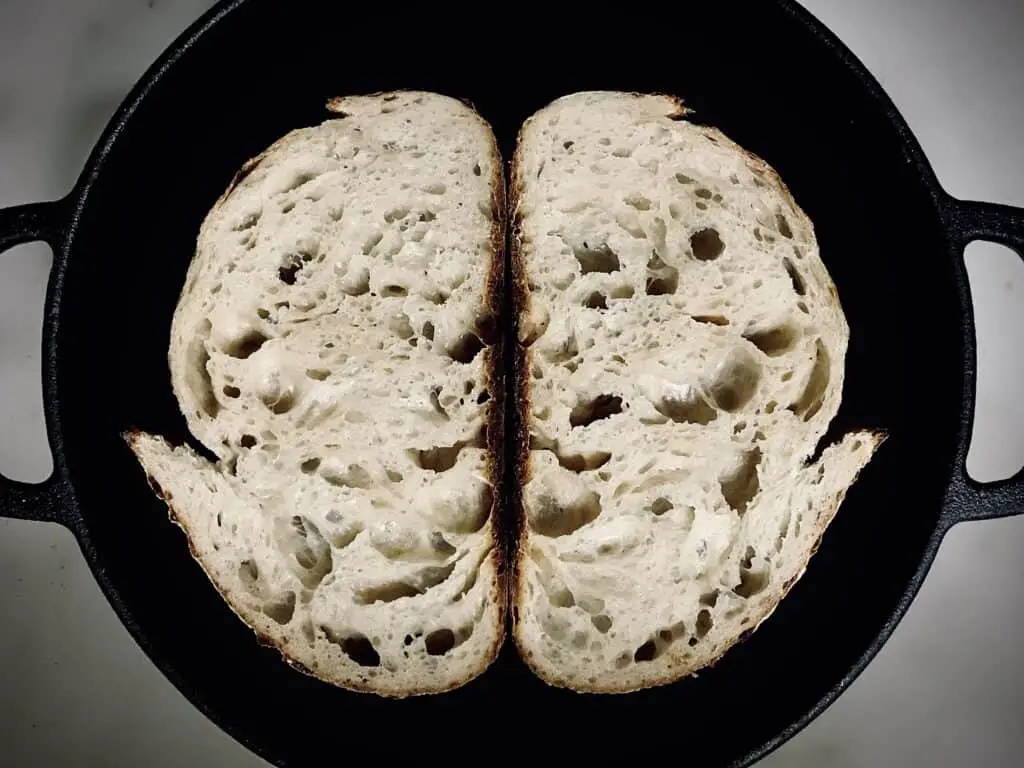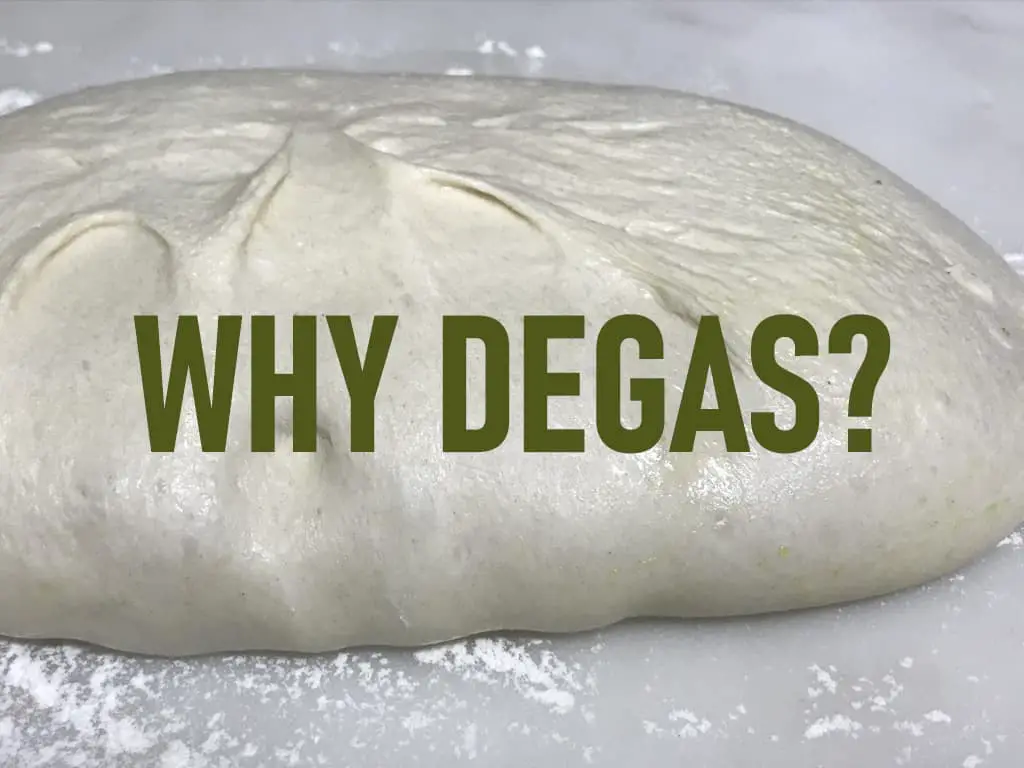If we want to use yeast to cause a rise in dough, it seems counterproductive to knock the rise out of it once it finally happens. I mean, nobody vacuums their floor and immediately dumps a bag of potting soil on it. At least I hope not.
In all seriousness though, there is a perfectly good reason (3 actually) as to why bread dough is often knocked down.
Bread dough is knocked down to relax gluten fibers. This keeps gluten from tearing and becoming weak. Weak gluten would result in weak and crumbly bread. Additionally, degassing dough removes large air pockets which creates a finer crumb.
However, not all bread calls for degassing or knocking down dough. This is because the purpose of degassing has as much to do with the process as it does the desired result.
Let’s discuss the 3 main reasons for degassing, from the most common to the least.
1. Finer Crumb

There isn’t a golden rule for how your crumb should look and feel. If the term crumb is new to you, it simply means the inside of your bread. Your crumb should simply end up the way you want it to be. But the caveat would be, if you’re aiming for a certain type of bread aim for that type of crumb.
For example, a baguette should look and feel like a baguette instead of a sandwich loaf. The textures of each bread are representative of their type of bread and what they are used for.
We’re not purists or anything, but if you invite me over for a croissant and give me a slice of cheesecake, I’ll be a bit confused. To be clear, I’d be happier to eat the cheesecake, but you and I both know that wasn’t a croissant.
So all that being said, one of the main reasons we knockout gas is to adjust the crumb in order to get the type of bread we are after or to simply suit our needs for using our bread.
The most common types of bread that are degassed are those used in sandwiches: sandwich loaves and buns.
When our aim is to use bread in a wet sandwich like a burger or pb&j, the finer the crumb the better (finer = no gaps).

I’ve tried to eat plenty of sloppy sandwiches on our open crumb sourdough (to your left). It’s delicious, but it involves a lot of hand-licking afterward. Not a problem when eating with my 5-year-old son, but a bit awkward when inviting the neighbors over.
Degassing makes a finer crumb because it shrinks air bubbles and reduces the strain on gluten fibers. Gluten fibers are what hold the dough together. Think of them like elastic bands, but elastic bands that start out weak and grow stronger over time. The first rise in dough often creates large air pockets because gluten is weaker in the beginning stages. Gluten can even tear if we allow the dough to rise too much. Degassing and letting dough rise again will develop smaller air bubbles since gluten is stronger the second time around.
2. To Avoid Over-proofing
In many cases when using commercial yeast (instant/active dry), the dough needs to be degassed to avoid over-proofing. Gluten in the early stages of a recipe is often given a head start in development by kneading. Kneading helps but isn’t enough to combat the power of instant yeast out of the gates.
Gluten will tear if it is allowed to rise too long. And it is more likely to happen during the first rise, as it is weaker at this stage. Additionally, torn gluten before shaping is especially a problem. It will be very hard to get a good shape during the shaping phase because tension is compromised. Everything just falls apart while trying to shape, like trying to carry groceries in a wet paper bag. Without a good shape, the final bake will likely end up a bit flat and dense.
The crumb also tends to be crumbly when over-proofed because gluten fibers tear and snap if over-proofed. Those gluten fibers are what bonds everything together and makes bread chewy. The goal is to have nice long interlocking fibers in a final loaf of bread.
By degassing, gluten stops before it gets to its breaking point, and has time to build even more strength during the second rise.
Good gluten development takes time. Degassing is a balancing act of getting enough gas trapped in dough while allowing gluten to fully develop without tearing. Degassing buys all of the time needed while protecting gluten from damage.
3. To Give Yeast More Nutrition
Yeast needs nutrition to produce gas, but the gas it produces creates space in dough. This is a problem in the sense that yeast is literally separating itself from its nutrition.
To combat the issue, bakers degas dough to bring yeast back in contact with more nutrition. The added benefit is that gluten is stronger at this new stage which keeps air bubbles smaller. This helps keep yeast closer for longer to its food supply.
Do I Need to Knock Down Dough?
No, you do not need to knock down dough; however, I would argue that nearly all varieties of bread are degassed in some way. Simply shaping dough, however gentle you are, will result in some loss of gas.
Depending on the outcome that you are looking for, you will want to completely degas (sandwich) or do everything in your power to keep as much gas in as possible (baguette).
The real answer though, should be, it depends.
Do you want big open holes in your bread? No, you should not degas.
Do you want a tight crumb without holes? Then yes, you should degas.
What About Pizza Dough?

Pizza dough is often knocked down twice and given a really long time to develop (often in the fridge). If you’re wondering why it needs to be knocked down twice especially since it often is given a lot of time to develop gluten, you’re in good company.
For pizza dough, the goal is very strong gluten. So it is common practice to let it rise to get enough initial development followed by a degassing like the above-mentioned bread types. But with pizza dough, once it is degassed, it is often shaped and placed in a fridge wich extends the proofing time further by slowing down yeast’s activity. This gives gluten a maximum amount of time to fully develop.
What is confusing here, is the dough is often taken out of the fridge and allowed to rise even more, just before knocking it back down again. But, in reality, the second knocking is not a complete degassing. In fact, I’d call it shaping more than knocking or degassing.
The technique often involves pressing in the middle of the dough in order to begin pushing gas towards the outer rim, which creates a light and fluffy crumb.
We are not so much knocking gas out of the center of the dough, but actually taking care to work slowly outward so as to move the gas out like a ripple or wave.
But the entire process has more to do with creating the maximum amount of gluten strength than it does anything else. It’s what creates the chewy yet crisp bite we all love about pizza.
As always, if you have more questions feel free to leave a comment!

